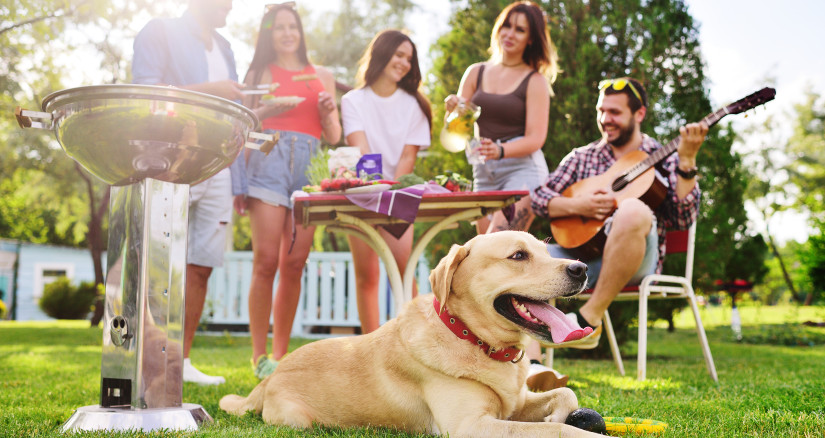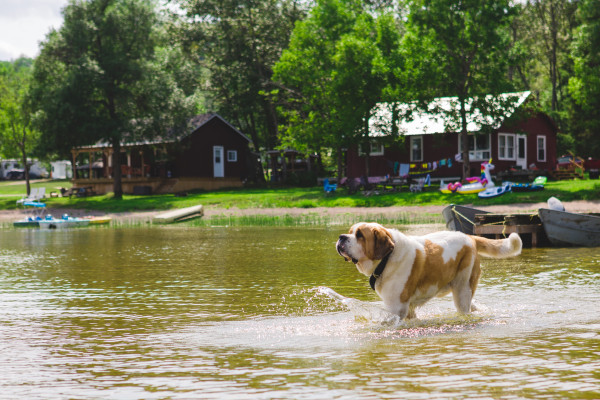
Summer Pet Safety: A Guide to Heat, Water, and Seasonal Hazards
As summer temperatures soar, pets face unique risks that can threaten their health and well-being. From sweltering heat and dangerous algae blooms to increased exposure to parasites and toxic picnic foods, the season’s excitement can quickly turn into an emergency for our furry companions.
While pets bring joy to summer adventures, owners must recognize the hazards they may encounter and take proactive steps to keep them safe. This guide examines key summer health concerns for pets, including symptoms to watch for, care strategies, and preventive measures informed by expert insights and current research.
Heat-Related Dangers: Recognizing Heatstroke in Pets
As temperatures rise, heatstroke is a leading concern for pets, particularly dogs with flat faces (brachycephalic breeds such as bulldogs, Boston Terriers, and pugs), elderly animals, overweight pets, and those with dark or thick coats. Signs of heatstroke include excessive panting, drooling, red gums, vomiting, diarrhea, lethargy, collapse, and in severe cases, seizures or loss of consciousness.
Heat exhaustion is a milder condition than heatstroke, which occurs when a dog becomes overheated and has not yet reached the critical temperature of heatstroke. Heat exhaustion can escalate to heatstroke if not treated promptly.
If you suspect heatstroke in your pet, immediately move them to a shaded or air-conditioned area, offer cool (not ice-cold) water, and apply cool, damp towels to their body, especially around the paws, groin, and armpits. Seek veterinary care urgently, as heatstroke can lead to organ failure or death.
Prevention is key: avoid walks during the hottest parts of the day, ensure access to shade and water, and never leave pets in parked cars, even for a few minutes.
Summer Skin Concerns: Sunburn and Allergies
Pets with light-colored or thin coats—such as white (with pink undertones) cats and dogs, horses with pink noses, and hairless cats and dogs—are prone to sunburn. Symptoms include redness, flaking, hair loss, and discomfort, typically on the ears, nose, or belly.
Protection includes pet-safe sunscreen (avoid zinc oxide for dogs), limiting sun exposure during peak hours, and providing shade. For horses, fly masks with UV protection can help. If sunburn occurs, consult a veterinarian for soothing treatments.
Environmental allergies also flare in summer, causing itchy skin, red or inflamed areas, ear infections, and excessive licking. Managing allergies may require the use of antihistamines, prescription medications, medicated shampoos, and/or flea control products. Consult with your veterinarian to determine what is best for your pet.

Photo by jennimareephoto
Algae and Water Safety: Cyanotoxins, Giardia, and Pets
Summer often means fun in the sun and refreshing dips in the water, but pet owners must be aware of hidden dangers that can lurk beneath the surface. From toxic algae blooms to invisible parasites like Giardia, natural water sources can pose serious risks to companion animals. Understanding these threats, how and where they occur, and how to protect pets from them is essential during the warmer months.
Cyanotoxins
Blue-green algae, also known as cyanobacteria, can form in lakes, ponds, and slow-moving rivers, particularly during warm weather. It appears as a green, blue-green, or brown scum or film on the water’s surface. Even minimal contact, such as swimming near it or licking it off fur, can expose pets to potent toxins, leading to drooling, vomiting, diarrhea, lethargy, tremors, difficulty breathing, seizures, or liver failure. Immediate veterinary care is essential if exposure is suspected. Prevention includes steering clear of water that appears discolored, has surface scum, or has posted advisories for algae blooms.
Geographically, cyanobacterial blooms are most often reported in regions with warm temperatures and nutrient-rich runoff. This includes parts of Oregon, Florida, Minnesota, California, and Wisconsin. Shallow lakes, areas with agricultural runoff, and stormwater-impacted ponds are particularly vulnerable to blooms. The Centers for Disease Control and Prevention (CDC) notes that harmful algal blooms (HABs) are becoming more common across the U.S. due to rising temperatures and changing precipitation patterns, making vigilance increasingly important during outdoor recreation.
Giardia
In addition to cyanobacteria, another waterborne threat to pets is Giardia duodenalis, a microscopic intestinal parasite that thrives in untreated or contaminated water. Giardia infects pets when they ingest water from puddles, streams, or stagnant bodies of water, especially those that are shared with wildlife or livestock.
Infected animals may show symptoms such as watery diarrhea, dehydration, weight loss, or abdominal discomfort, although some cases are asymptomatic. Dogs that frequent natural water sources while hiking or camping are particularly at risk. Giardia is not only a common cause of gastrointestinal illness in dogs, but it is also zoonotic, meaning it can potentially spread between animals and humans through fecal contamination.
Regions where Giardia is most prevalent include mountainous areas with high wildlife populations, such as parts of the Pacific Northwest, the Appalachian Trail region, and the Rocky Mountains. Natural springs and backcountry streams may appear clean, but can carry Giardia cysts, which are dormant eggs. Recreational water parks and dog parks with standing water also carry risk, particularly where sanitation is poor or drainage is inadequate.
Water Safety
Beyond these microbial threats, general water safety is critical. Dogs and other pets can tire quickly in the water, especially in strong currents or deep lakes. Not all dogs are natural swimmers, and certain breeds, such as bulldogs, pugs, and dachshunds, are at a higher risk of drowning due to their body shape and respiratory challenges. Pet life jackets are recommended for boating, paddleboarding, or swimming in unfamiliar or rough water. Supervise pets closely, teach them safe water entry and exit points, and avoid throwing toys into deep water if the pet is uncomfortable.
After swimming, rinse pets thoroughly to remove chlorine, salt, or algae, and dry ears to prevent infections. Watch for signs of water intoxication, a rare but serious condition where excessive water ingestion leads to vomiting, lethargy, bloating, or seizures.
Summer Pests: Fleas, Ticks, and Mosquito-Borne Diseases
Warmer weather increases exposure to fleas, ticks, and mosquitoes, which are vectors for diseases such as Lyme disease, heartworm, ehrlichiosis, and anaplasmosis. Symptoms vary by disease but may include fever, lethargy, joint pain, coughing, weight loss, or anemia.
Prevention includes year-round use of veterinarian-recommended parasite preventatives (oral, topical, or collars), regular tick checks after outdoor activities, and minimizing mosquito breeding areas by removing standing water. Prompt removal of ticks (using tweezers or a tick tool) is critical; grasp close to the skin and pull gently. If symptoms develop after a tick bite, seek veterinary care for diagnostic testing and early treatment.
BBQ and Picnic Hazards: Food Toxins and Emergencies
Summer picnics pose risks from human foods that are toxic to pets. Grapes, raisins, onions, garlic, alcohol, bones, corn cobs, and chocolate can lead to severe illness or death. For example, grape ingestion can cause kidney failure in dogs, while onions and garlic can cause life-threatening anemia.
Symptoms of food toxicity include vomiting, diarrhea, abdominal pain, weakness, tremors, seizures, and collapse. If ingestion occurs, contact your veterinarian or a poison hotline immediately.
Safe alternatives to including your pet in cookout festivities include pet-friendly frozen treats (like plain yogurt or fruit purees), pet-specific chews, and supervised play.

Photo by puhimec
Pocket Pet Care: Small Animals and Heat Risk
Rabbits, guinea pigs, hamsters, and other small mammals are extremely sensitive to heat, as they lack the ability to sweat. Signs of heat stress include lethargy, rapid breathing, drooling, and collapse.
Keep small pets in a cool, shaded, and well-ventilated area during the warmer months. Offer frozen water bottles wrapped in towels for cooling, provide fresh greens for hydration, and avoid handling during the hottest parts of the day. Seek veterinary care immediately if symptoms of heat stress appear.
Final Takeaways: Summer Safety Checklist
- Provide shade, fresh water, and cool spaces
- Avoid hot surfaces and midday walks
- Use parasite preventatives (all year-round)
- Keep pets away from BBQ foods and unknown, and stagnant water sources
- Watch for signs of heatstroke/heat exhaustion, algae poisoning, and allergies
- Know your pet’s species-specific risks and care needs
By staying informed and proactive, pet owners can help their companions enjoy a safe, healthy, and happy summer season. The BSM Partners Veterinary Services team is ready to help with critical care services. Also, keep an eye out for BSM’s Barking Mad Podcast for more up-to-date information.
Follow us on LinkedIn for the latest updates on all things happening here at BSM Partners.
About the Author
Lee Ann Hagerty is Director of Customer Enrichment and Consumer Insights on the BSM Product Innovation team with 29+ years in the pet food industry, working for Iams/Eukanuba, Procter & Gamble, and Mars Pet Care. She brings a unique combination of project management skills with consumer insights, product design, animal nutrition, and sensory science which drives an in-depth understanding of the pet and consumer. Lee Ann has a passion for helping dogs. Over the last year and a half, she has fostered over 22 dogs. Many of them were senior dogs who had lived their entire lives outside as hunting dogs. She has been a foster pet parent for many years, and it brings her great joy to see these pets find fur-ever homes where they live with families indoors with love and care.
This content is the property of BSM Partners. Reproduction or retransmission or repurposing of any portion of this content is expressly prohibited without the approval of BSM Partners and is governed by the terms and conditions explained here.